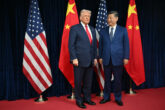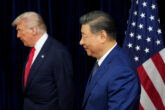October 30, 2018
Navigating a new chapter in the US-Philippines’ ‘Long Friendship’
In the Philippines, nearly a year after President Trump first sketched his Free and Open Indo-Pacific policy at the 2017 APEC CEO Summit, uncertainty about how the United States will operationalize its vision lingers. Beijing’s vaunted infusion of capital, and influence across all dimensions of Philippine society, including through its multi-billion dollar investments into key Build, Build, Build infrastructure projects, has amplified this uncertainty. Indeed, the common refrain in Manila is that while the United States remains a good friend, China will always be the Philippines’ watchful, at times menacing, northern neighbor.
As the United States operationalizes its Indo-Pacific policy, it will need to ever more conscientiously strike a balance between providing assurances of the durability of US commitment to the region and encouraging Philippine autonomy, particularly amidst Chinese incursions. The United States will also need to grapple with how best to promote its positive agenda for a rules-based order in a way that not only safeguards its own interests but also directly appeals to the aspiring middle classes of the Philippines and beyond.
The Indo-Pacific framework, at its core, underscores the shift in the global economic center of gravity and other dramatic changes that are afoot both in the Philippines and across Southeast Asia. Yet, despite the sharp contrast between today’s mercurial leaders and their predecessors, the elements of continuity in policy dwarf elements of change both in the United States and the Philippines. Across the diplomatic, economic, and security domains, the American commitment to the rule of law, freedom of navigation, sustainable economic development, and good governance both in the Philippines and the region writ large remains stronger than ever before.
Diplomatically, the United States’ Indo-Pacific policy in Southeast Asia is predicated on ASEAN centrality, as the Deputy Secretary of State recently highlighted at the ASEAN Ministerial meeting. At the same time, while ASEAN is most powerful when it speaks with a unified voice, there is also growing utility in minilateralism and more nimble, ad hoc cooperation below the ASEAN level. The Philippines’ trilateral air and maritime patrols with Indonesia and Malaysia in the Sulu and Celebes Seas offer a case in point. Moving forward, the United States should not only support ASEAN cohesion but also smaller, effective coalitions of the willing to showcase American and regional commitment to a rules-based order.
Read the full article on the Stratbase ADR Institute website.
More from CNAS
-
Chinese Maker of Bitcoin-Mining Machines Is a Security Threat, Says Expert
Bloomberg News reports that a Chinese manufacturer, Bitmain Technologies Ltd, that sells most of the world’s Bitcoin-mining machines — including 16,000 of them to a venture ba...
By David Feith
-
Indo-Pacific Security / Energy, Economics & Security
North Korea’s Provocations, Power Plays, and Shifting AlliancesTensions on the Korean Peninsula have reached a new and dangerous threshold. President Lee Jae Myung is warning of a real risk of accidental military clashes, as the situation...
By Dr. Go Myong-Hyun
-
Indo-Pacific Security / Energy, Economics & Security
How to Win the Economic War with ChinaTrump's approach to China has run aground, giving Beijing unprecedented advantage in the economic conflict....
By Edward Fishman & Julian Gewirtz
-
Indo-Pacific Security / Technology & National Security
Sharper: Tech + ChinaRecent talks between President Donald Trump and Chinese Communist Party General Secretary Xi Jinping placed a spotlight on emerging technologies, from high-end chips to minera...
By Charles Horn & Sevi Silvia




